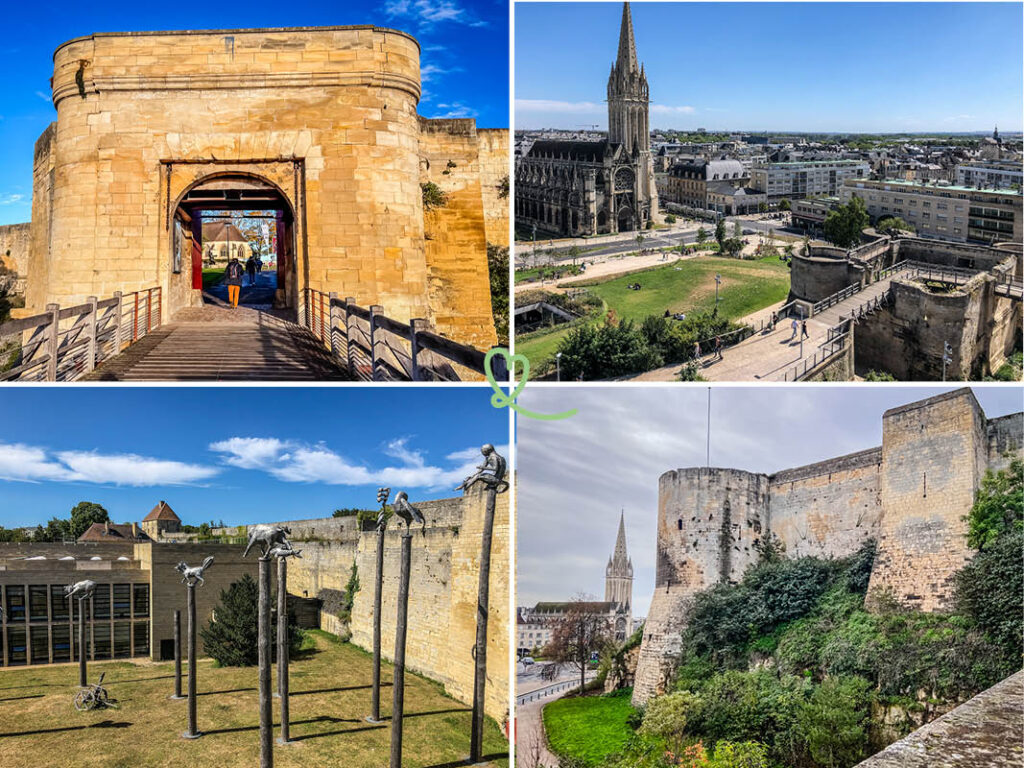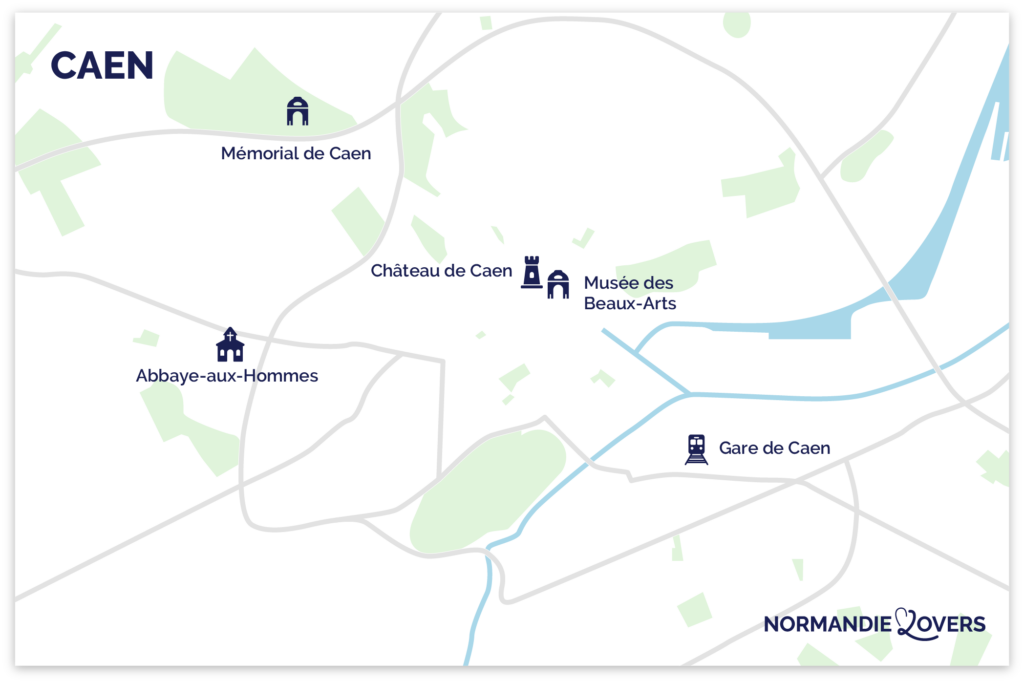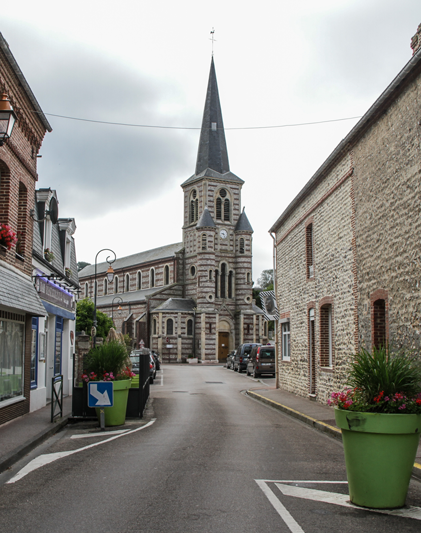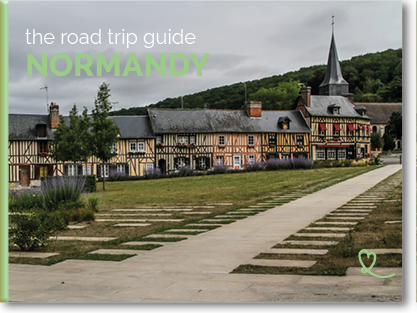If you’re visiting the city of Caen for the weekend or on vacation, take a look here. visit the Château de Caen. Built at the beginning of the 2nd millennium by William the ConquerorThis fortress is one of the oldest and largest in Europe!
Restored ramparts, remains of the keep, museums in the ducal castle grounds… You’ll be amazed by the rich heritage of this place of art and history.
In this article, you’ll find all our advice and our opinion in pictures to help you prepare for your getaway. Enjoy your visit!

This review is completely independent, we visited anonymously and paid our admission in full.
Why visit Caen Castle?
Is the Château du Ducal worth a visit?
Absolutely. Right in the heart of the city, this building has witnessed the city’s history for almost a thousand years! In fact, we’ve listed it among our ideas of things to do in Caen for several reasons:
- Rich history: this castle, which played a crucial role in the history of Normandy, has a fascinating history dating back to the Middle Ages, when it was built under William the Conqueror.

- Its architecture: now the main residence of the Dukes of Normandy, kings of England, this fortified enclosure offers an immersive experience of the medieval past.

- Its affinity with art: inside the château, you can visit the Musée de Normandie and the Musée des Beaux-Arts, which house a rich collection of historical artifacts and works of art from different eras.

Why is the Château de Caen famous?
Built on the orders of William the Conqueror, whose exploits are recounted in the famous Bayeux Tapestry, the Duke of Normandy and King of England and his descendants made this castle their home. Indeed, this fortress owes its fame to its crucial role in the history and future of the region.
Did you know that it was from Caen Castle that William the Conqueror set out to conquer the English crown in 1066?

What we liked best
You’ll find the details of our experience in this article, but we wanted to share our favorite moments with you right away:
- The Church of Saint-Georges, a blend of several architectural styles, witnessed key moments in French history from the Middle Ages to the bombings of 1944.
- The Salle de l’Échiquier, which could accommodate up to 1,000 knights for the duchy of Normandy’s receptions.
- The keep with its large moat, nearly 30m high in the 12th century.

Subscribe to our Newsletter
- Get away from it all with Region Lovers’ beautiful destinations!
- Once a month
- Advertising-free
Practical tips and map: Caen Castle, Normandy, France.
Where is the castle?
Château de Caen is located in downtown Caen (14000), Normandy.

- Driving time from Rouen: 1h30min.
- Driving time from Évreux: 1h40min.
- Driving time from Alençon: 1h10min.
- Driving time from Cherbourg: 1h30min.
- Driving time from Mont-Saint-Michel: 1h30min.
How to get there
We recommend that you drive to Caen if you also wish to visit the rest of Normandy without constraints. Just a 15-minute drive from the center, Caen-Carpiquet airport is also accessible from several cities. Find out more about flights here.
Otherwise, the train is a more convenient means of transport. Caen’s outlying roads are often subject to traffic jams at peak times, as is the historic center. Traffic doesn’t always flow smoothly.
See available timetables and book your train and coach tickets now.
Regular TER lines serve Caen from Paris Saint-Lazare, as well as from Le Mans and Rennes.
From Caen station, it’s just under a 30-minute walk to the château.

By bus, you can get off at the University or Château-Quatrans stops. See details on the official Caen Mobility Network website here.
If you prefer the streetcar, you can take line 2 and get off at the Château Quatrans stop.
And don’t forget your bike. The municipality is building cycle paths to enable cyclists to move around town more freely. Find out more here.

Parking
The château has a dedicated parking lot for visitors. However, you can park your vehicle outside the grounds in paying parking lots:
- the Indigo “Château” underground parking lot at 60 avenue de la Libération,
- the “Courtonne” outdoor parking lot on Quai Vendeuvre.

OUR ADVICE FOR RENTING A CAR IN Normandy
- Compare prices on our preferred platform: DiscoverCars – one of the best rated sites.
- Choose a car that is comfortable enough (distances can be long) but compact (some parking lots and villages are narrow).
- Think of thecomplete insurance (some roads are tortuous and narrow).
- There is a lot of demand, book it early.

Schedules and rates
The Château de Caen is open to visitors every day, but closed at night.
Admission and tours of the château are free.
Access to the Musée des Beaux-Arts and the Musée de Normandie inside the estate is subject to a ticket charge. We invite you to read the details in our respective articles here and here.
Best time to visit the castle
We advise you to visit outside the peak season (July and August), as tourist numbers can be quite high. Spring is often considered one of the best seasons to visit Caen castle. The weather is generally pleasant, with mild temperatures and sunny days. What’s more, the gardens around the château are in full bloom, providing a picturesque backdrop for your visit.

September and October are also ideal times to visit this Caen landmark. Temperatures are still fairly mild, and there are fewer crowds than in the high summer season.
How long to visit
The time required to visit the Ducal Castle may vary according to your interest in history, architecture and museums, and the pace of your visit. In general, for a detailed and complete visit including the 2 museums, you should allow around 2 to 3 hours. If you’re only visiting the castle grounds, 1h to 1h30 maximum should suffice. Allow a little extra time to stroll through the castle’s gardens and outdoor spaces, take in the panoramic views and soak up the historic atmosphere.

Tips for visiting
The direction of visit is not imposed. So you can explore the castle at your own pace, and in the order that suits you best.
Don’t forget to ask for a map when you arrive at the château. This allows you to decide on the route you want to take, taking into account your preferences and interests.

The Ducal Castle with children
For €2.50, Caen’s tourist office offers a book-game for children to discover the city’s historic center.
With this booklet, you and your children can explore the castle and Caen independently, via 2 fun routes. Sense of observation, orientation, reading, drawing… The activities are really varied and adapted to 2 age groups: 4 to 7 years and 7 to 13 years. Find all the details on the official website here.

DISCOVER Caen
- What to do in Caen
- Where to stay in Caen: our best hotels
- Where to eat in Caen: our best restaurants
- Caen’s best museums
- Itineraries: 1 day – 2 days
- Caen Castle
- Caen Memorial Museum
- Rent a car in Caen: our tips

The château’s restaurant: Le Mancel
The château’s restaurant, Le Mancel, is open:
- Wednesday to Saturday, 9am to 2pm and 7pm to 10pm. A tea room is available from 2pm to 7pm.
- Sundays from 9am to 2pm and as a tea room from 2pm to 7pm.
- closed Mondays and Tuesdays all day, Sunday evenings and December 24 and 25.
You can enjoy a starter/main course/dessert menu for around 30 euros.

Nearby restaurants
Caen is a city with many varied and tasty restaurants. Here is a selection of three establishments featured in our article on the best restaurants to eat in Caen:
- La Vraie Vie: this restaurant, a 5-minute walk from the abbey, offers refined cuisine that changes with the seasons, in a friendly atmosphere.
- Restaurant L’Aromate: Axel de Caseneuve and Inès de Saint Jores’ bistronomic table is a real invitation to travel, and we were transported!
- Bar-restaurant Moon & Sons: this subdued pub inspired by the world of Harry Potter offers a 100% plant-based menu (dishes, pastries and snacks).
WHERE TO STAY IN Caen
Option 1: in the old town center
We recommend..:
- Hotel Best Western Plus Le moderne not far from the castle – see prices, photos and availability
- Hotel La Fontaine also near the castle – see prices, photos and availability
- B&B Les Chambres de L’Abbaye, near Abbaye-aux-Hommes – see prices, photos and availability

Option 2: to Ouistreham
To sleep more in the countryside or near the beach (15 to 20min from Rouen). We recommend..:
- Hotel Manoir Hastings and its stone houses – see prices, photos and availability.
- Hotel La Mare Ô Poissons and its swimming pool – see prices, photos and availability

Option 3: near the port or station
We recommend..:
- Campanile hotel next to the station – see prices, photos and availability.

The Ducal Castle, fortress and residence
William the Conqueror strengthened the power and prosperity of his duchy during the feudal era. To protect his lands in Normandy, he built more and more fortresses. To establish his power, he chose Caen, the 2nd capital after Rouen. Both a pleasure residence and a military fort, the Duke of Normandy and King of England regularly gathered his court here. On this tour, you’ll learn about the functions of this ducal castle, which made a major contribution to the town’s development.

An 11th-century fortress
Although research and excavations have not yet revealed all the phases of construction, archaeologists believe that the very first rampart built around the castle was made of wood. Square stone towers and a stone structure were added in the 12th century. You’ll discover the remains of the ramparts, which measure nearly 800m in length! This fortress covers some 5 hectares, making it one of the largest in Europe. Thanks to the restoration of the ramparts, you’ll be able to climb up and admire panoramic views over the town and the estate.

Did you know that Queen Matilda, Duchess of Normandy and wife of William the Conqueror, had one of the towers built in her name 2 centuries after her death? The function of the Queen Mathilde Tower was to reinforce the security and defense of the castle where the ramparts joined those of the town.

You’ll see a number of different entrances to the castle, which have evolved over time. The Porte Saint-Pierre to the south, for example, was originally a poterne, a small, discreet door built into the fortifications to allow inhabitants to escape in the event of a siege. It was then transformed into a fortified gateway to the city.

Another example is the Porte des Champs, built in the 12th century under the reign of Philippe Auguste. From the top of its 2 towers, it underwent major alterations at the start of the Hundred Years’ War, including a central body to install an arrow drawbridge. Defending the fortress was a real strategy that had to adapt to a changing environment. You’ll be able to admire this gateway, still intact despite the bombardments of 1944, a major example of medieval architecture. This is one of our favorite sections of the tour!

The Old Palace and the Salle de l’Échiquier
The visit continues with the Salle de L’Échiquier, built in the 12th century by Henri I Beauclerc, son of William the Conqueror. You’ll notice the characteristic Romanesque architecture, with its exposed wooden beams. Look up to see the arches and ornamentation around the windows that let in the light. Do you realize that this hall was able to accommodate up to 1,000 knights for the reception of the Great Christmas Court over 8 centuries ago?

During various archaeological excavations in the 20th century, the remains of William the Conqueror’s Old Palace revealed a large reception hall, ceremonial apartments and a palatine chapel. The château served as a residence not only for the Duke of Normandy and King of England, but also for the garrison and the military. You’ll see that the demarcation of spaces is still clearly visible in the ruins of this part of the castle.

USE OUR GUIDE TO PLAN A
DREAM TRIP TO Normandy
All the information you need for your trip:
- 8 maps that make planning easier
- 160+ pre-selected locations
- Practical advice
- 300+ photos to help you choose

From the Middle Ages to the 18th century
Visit Saint-Georges Church
We continued our tour with a visit to St. George’s Church. This historic site was built in the 11th century and modified until the Renaissance. Did you know that this is one of Caen’s oldest parish churches? From its 1st construction in the Middle Ages in Romanesque style, the 2 walls that support the nave remain. Take time to look carefully at the windows that illuminate the main ship, their style is somewhat different as they were designed 3 centuries later.

After having been the parish church of the inhabitants and soldiers living within the castle walls, this place of worship was disused during the Revolution of 1789. Following the bombardment of the Normandy landings in June 1944, the church was restored as part of a major renovation project, and became the site for the Musée des Beaux-Arts and Musée de Normandie, located inside the château. You can also buy souvenirs during your visit. Have you noticed the arcades and colourful stained glass windows inside?

Explore the missing dungeon
If you go a little further, you’ll come close to the lost keep of Caen Castle. Imagine in front of you an almost 30-metre-high structure, no longer standing, that served as an observation point, a firing post and possibly a last refuge if the fortification were to be taken by the enemy! In the 13th century, the French king Philippe II, known as “Auguste”, had a large moat built around the keep. You can see the ruins that have remained since 1793.

From the Logis des Gouverneurs to the Musée de Normandie
Next stop: the former Logis des Gouverneurs, now home to the Musée de Normandie. This museum offers an in-depth look at Norman daily life, traditions and expertise through the centuries. It’s an enriching visit for history buffs and those wishing to learn more about Normandy. Built in the 14th century with a few adjustments in the following 2 centuries, the Logis des Gouverneurs (Governors’ Lodging House), only one Renaissance wing remains today. On the outside, you’ll notice the large mullioned windows that divide it vertically, typical of the architecture of the period. As well as the lovely 16th-century garden.

Did you know that the Logis des Gouverneurs lived many lives before becoming the home of the Musée de Normandie? After the Revolution and from 1875 onwards, it housed officers’ and military administration offices, but was partly destroyed during the 2nd World War. If you look carefully, you can make out the letterbox, still in place, the last vestige of the Logis’ military function!
OUR ADVICE FOR RENTING A CAR IN Normandy
- Compare prices on our preferred platform: DiscoverCars – one of the best rated sites.
- Choose a car that is comfortable enough (distances can be long) but compact (some parking lots and villages are narrow).
- Think of thecomplete insurance (some roads are tortuous and narrow).
- There is a lot of demand, book it early.

The Château de Caen, a place of art and history
Sculpture Park
Laid out in 2007, the Sculpture Park is attached to the Musée des Beaux-Arts de Caen, housed within the château. In this natural setting, contemporary sculptures by leading artists blend into the landscape, some perched on tall wooden trunks. You’ll find works by Auguste Rodin, Marta Pan and Antoine Bourdelle. During the redevelopment of the Château de Caen, the sculptures will be temporarily relocated to Caen town hall, or stored in a suitable location.

The Museum of Fine Arts
Located inside the castle ramparts, Caen’s Musée des Beaux-Arts is one of France’s leading museums of European Renaissance and Grand Siècle painting. His collection of prints is also well known. If you’re a fan of contemporary art, you’ll also be delighted by the rooms devoted to the avant-gardes of the 19th and 20th centuries. At the entrance to the museum, for example, you can admire the famous face of a little girl called Lou, by artist Jaume Plensa. You won’t want to miss this trompe-l’œil sculpture, which we loved and which has become emblematic of Caen.

Subscribe to our Newsletter
- Get away from it all with Region Lovers’ beautiful destinations!
- Once a month
- Advertising-free
End of the tour: Jardin des Simples and Caserne Lefèbvre
You’ve reached the end of your tour, but don’t leave just yet! Stroll through the Jardins des Simples, designed after the Hundred Years’ War. Many plants and herbs traditionally used for medicinal and culinary preparations were planted here. Enjoy a moment of relaxation in this Renaissance garden, still a meeting place today.

Finally, enjoy a 3D reconstruction of the Lefèbvre barracks, which from 1875 served as a guardhouse, artillery and military administration building.
Compulsory military service since the end of the 18th century has profoundly transformed Caen castle. The fortress was home to several hundred men of the prestigious 36th InfantryRegiment , first engaged in the Ardennes during WW1.
So, are you ready for a visit steeped in history?

PLAN YOUR TRIP TO Normandy
Inspiration destinations
- Deciding where to go in Normandy – the best destinations
- Our weekend ideas: best-of, romantic, unusual, seaside, luxury, family
- 16 seaside hotels in Normandy
- The most beautiful charming hotels in Normandy

Best of

Practice
- Where to stay in Normandy – best places and hotels
- See our tips for renting a car at CDG airport, Orly airport, Beauvais airport, Caen, Rouen, Bayeux…

A little history
After several victories during the 1st half of the 11th century, William the Conqueror established his power in Caen by building the Château ducal around 1060, a few years before the conquest of England. This made Caen the 2nd capital of western Normandy, after Rouen.

The Château de Caen reveals the strategically astute character of William the Conqueror, Duke of Normandy and King of England. In fact, it was built to dominate the Orne Valley and the various passageways.

This fortress will live on through the ages, witnessing key moments in French history. The influence of Normandy, the Hundred Years’ War, the French Revolution at the end of the 18th century and the D-Day landings in 1944… These milestones mark the history of the fortress and the region. This journey through the ages is also reflected in the combination of different architectural styles in the remaining buildings. The Château de Caen is no longer inhabited, but has become a place for art, history and encounters.
All our tips in this article were put into words with the help of Myriam.



